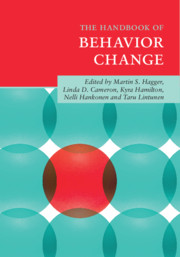Book contents
- The Handbook of Behavior Change
- The Handbook of Behavior Change
- Copyright page
- Dedication
- Contents
- Figures
- Tables
- Sidebars
- Contributors
- 1 Changing Behavior: A Theory- and Evidence-Based Approach
- Part I Theory and Behavior Change
- 2 Changing Behavior Using the Theory of Planned Behavior
- 3 Changing Behavior Using Social Cognitive Theory
- 4 Changing Behavior Using the Health Belief Model and Protection Motivation Theory
- 5 Changing Behavior Using the Common-Sense Model of Self-Regulation
- 6 Changing Behavior Using the Model of Action Phases
- 7 Changing Behavior Using the Health Action Process Approach
- 8 Changing Behavior Using Self-Determination Theory
- 9 Changing Behavior Using Control Theory
- 10 Changing Behavior Using the Transtheoretical Model
- 11 Changing Behavior Using Integrative Self-Control Theory
- 12 Changing Behavior Using the Reflective-Impulsive Model
- 13 Changing Behavior Using Habit Theory
- 14 Changing Behavior by Changing Environments
- 15 Changing Behavior Using Integrated Theories
- 16 Changing Behavior Using Social Identity Processes
- 17 Changing Behavior Using Ecological Models
- 18 Changing Behavior Using Theories at the Interpersonal, Organizational, Community, and Societal Levels
- Part II Methods and Processes of Behavior Change: Intervention Development, Application, and Translation
- Part III Behavior Change Interventions: Practical Guides to Behavior Change
- Index
- References
14 - Changing Behavior by Changing Environments
from Part I - Theory and Behavior Change
Published online by Cambridge University Press: 04 July 2020
- The Handbook of Behavior Change
- The Handbook of Behavior Change
- Copyright page
- Dedication
- Contents
- Figures
- Tables
- Sidebars
- Contributors
- 1 Changing Behavior: A Theory- and Evidence-Based Approach
- Part I Theory and Behavior Change
- 2 Changing Behavior Using the Theory of Planned Behavior
- 3 Changing Behavior Using Social Cognitive Theory
- 4 Changing Behavior Using the Health Belief Model and Protection Motivation Theory
- 5 Changing Behavior Using the Common-Sense Model of Self-Regulation
- 6 Changing Behavior Using the Model of Action Phases
- 7 Changing Behavior Using the Health Action Process Approach
- 8 Changing Behavior Using Self-Determination Theory
- 9 Changing Behavior Using Control Theory
- 10 Changing Behavior Using the Transtheoretical Model
- 11 Changing Behavior Using Integrative Self-Control Theory
- 12 Changing Behavior Using the Reflective-Impulsive Model
- 13 Changing Behavior Using Habit Theory
- 14 Changing Behavior by Changing Environments
- 15 Changing Behavior Using Integrated Theories
- 16 Changing Behavior Using Social Identity Processes
- 17 Changing Behavior Using Ecological Models
- 18 Changing Behavior Using Theories at the Interpersonal, Organizational, Community, and Societal Levels
- Part II Methods and Processes of Behavior Change: Intervention Development, Application, and Translation
- Part III Behavior Change Interventions: Practical Guides to Behavior Change
- Index
- References
Summary
Behavioral determinants with the largest effects are often those related to the environments in which behaviors occur. This suggests the merits of a shift in focus of changing behavior at scale away from interventions based on deliberation and decision-making and toward interventions that involve changing cues – physical, digital, social, and economic – in environments. This chapter focuses on changing cues in small-scale physical environments – sometimes known as choice architecture or nudge interventions. Despite attracting much interest, these interventions have been little explored from a theoretical perspective. Exploring the mechanisms by which some of these interventions exert their effects provides a starting point. Examining evidence of three interventions – increasing availability of healthier food options, reducing glass size, and putting warning labels on food and alcohol products – suggests no single theory explains their effects. The mechanisms by which these interventions affect behavior change also necessitate different levels of explanation and demand a theoretical framework that applies at different levels. Recognizing the distinction between model-free and model-based learning and behavior may be central to this. Advancing knowledge on changing behavior by changing environments requires robustly designed field studies to estimate effect sizes, complemented by laboratory studies testing mechanisms to optimize interventions and develop theoretical understanding.
Keywords
- Type
- Chapter
- Information
- The Handbook of Behavior Change , pp. 193 - 207Publisher: Cambridge University PressPrint publication year: 2020



